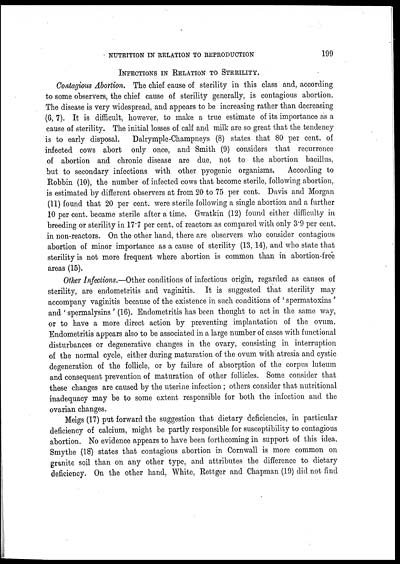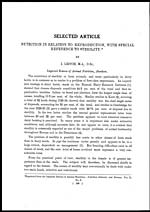Medicine - Veterinary > Veterinary colleges and laboratories > Indian journal of veterinary science and animal husbandry > Volume 3, 1933 > Original articles > Nutrition in relation to reproduction, with special reference to sterility
(257) Page 199
Download files
Individual page:
Thumbnail gallery: Grid view | List view

NUTRITION IN RELATION TO REPRODUCTION 199
INFECTIONS IN RELATION TO STERILITY.
Contagious Abortion. The chief cause of sterility in this class and, according
to some observers, the chief cause of sterility generally, is contagious abortion.
The disease is very widespread, and appears to be increasing rather than decreasing
(6, 7). It is difficult, however, to make a true estimate of its importance as a
cause of sterility. The initial losses of calf and milk are so great that the tendency
is to early disposal. Dalrymple-Champneys (8) states that 80 per cent. of
infected cows abort only once, and Smith (9) considers that recurrence
of abortion and chronic disease are due, not to the abortion bacillus,
but to secondary infections with other pyogenic organisms. According to
Robbin (10), the number of infected cows that become sterile, following abortion,
is estimated by different observers at from 20 to 75 per cent. Davis and Morgan
(11) found that 20 per cent. were sterile following a single abortion and a further
10 per cent. became sterile after a time. Gwatkin (12) found either difficulty in
breeding or sterility in 17.7 per cent. of reactors as compared with only 3.9 per cent.
in non-reactors. On the other hand, there are observers who consider contagious
abortion of minor importance as a cause of sterility (13, 14), and who state that
sterility is not more frequent where abortion is common than in abortion-free
areas (15).
Other Infections.—Other conditions of infectious origin, regarded as causes of
sterility, are endometritis and vaginitis. It is suggested that sterility may
accompany vaginitis because of the existence in such conditions of ' spermatoxins '
and ' spermalysins' (16). Endometritis has been thought to act in the same way,
or to have a more direct action by preventing implantation of the ovum.
Endometritis appears also to be associated in a large number of cases with functional
disturbances or degenerative changes in the ovary, consisting in interruption
of the normal cycle, either during maturation of the ovum with atresia and cystic
degeneration of the follicle, or by failure of absorption of the corpus luteum
and consequent prevention of maturation of other follicles. Some consider that
these changes are caused by the uterine infection; others consider that nutritional
inadequacy may be to some extent responsible for both the infection and the
ovarian changes.
Meigs (17) put forward the suggestion that dietary deficiencies, in particular
deficiency of calcium, might be partly responsible for susceptibility to contagious
abortion. No evidence appears to have been forthcoming in support of this idea.
Smythe (18) states that contagious abortion in Cornwall is more common on
granite soil than on any other type, and attributes the difference to dietary
deficiency. On the other hand, White, Rettger and Chapman (19) did not find
Set display mode to: Large image | Zoom image | Transcription
Images and transcriptions on this page, including medium image downloads, may be used under the Creative Commons Attribution 4.0 International Licence unless otherwise stated. ![]()
| Permanent URL | https://digital.nls.uk/75230215 |
|---|
| Description | Covers articles from 1933. |
|---|




